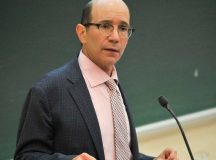Yisrael Medad is deputy editor of the forthcoming critical English-language edition of the writings of the revisionist Zionist Ze’ev Jabotinsky, and is Research Fellow at the Menachem Begin Heritage Center in Jerusalem. In this essay, he examines Jabotinsky’s 1906 pamphlet ‘The Bund and Zionism’ as a window on the historic battle between Zionists and Bundists for the soul of the Jewish people. Medad also stresses the contemporary relevance of the pamphlet at a time when there are signs of a neo-Bundist revival in the West. As ever, the editors welcome responses from our readers.
In the last two decades of the 19thcentury, there arose in the Russian Empire two political, social and cultural movements among the Jewish population that would compete for the leadership of Jewish masses for decades to come. They battled in homes, splitting apart families, and they argued in the streets and the synagogues. They confronted each other in elections for the governmental institutions of the non-Jewish countries in which they resided. They organised internally and propagandised externally, and they composed songs, wrote novels, published newspapers, demonstrated, and at times even battled each other.
One won out and accomplished almost all its goals. It did establish what it set out to do, to reconstitute the Jewish national home, but was late and lost almost all those it had thought to save. The other, although winning for most of the time, garnering the major membership support, died out, taking with it so many Jewish souls and bodies in a fruitless and senseless attempt to be at home in the Diaspora.
One was the Zionist movement and the other the Bund, the secular Jewishsocialist party in the Russian Empire until the Bolshevik Revolution (and afterwards, mainly in Poland).As the academic Joseph Nedava noted, ‘ever since their clash in the Jewish arena in Russia’ Zionism and the Bund became the bitterest antagonists in a struggle for the soul of the Jewish masses.
As Deputy-Editor of the forthcoming volumes of Ze’ev (Vladimir) Jabotinsky’s selected writings in a critical edition, I have translated and annotated a booklet he published in 1906, ‘Bund i Sionizm’ [The Bund and Zionism]. While both movements made their official appearance in 1897 —the Bund in Vilna in October and the World Zionist Organisation two months earlier in August in Basle —both had roots in earlier publications and actions. Jabotinsky mounted a fundamental intellectual challenge to the Bund, engaging its spokespersons across Russia and beyond.
The celebrated Bund leader Raphael Abramovich relates in his 1944 memoirs, In Tsvay Revolutsyes [In Two Revolutions], ‘In one of my speaking appearances, I think, in Karlsruhe or Stuttgart, I had a remarkable opponent: a young man with a rounded head, a noticeably protruding chin, and a big expressive “actor’s” mouth. None of my Bundist friends knew who he was: they just knew that he was a Zionist who was reputedly a good speaker. But when that young Zionist began to speak — and he commenced with a wonderful quote from the prophet Amos — the whole crowd turned to him, for they sensed in him an unusual oratorical power. And the first one to admire him was I myself, the lecturer, whom he opposed (…) only later was I informed that the young Zionist was Vladimir Jabotinsky. A year and a half later [1905] I encountered him in a series of debates in St. Petersburg’.
In his pamphlet, Jabotinsky deals with the Bund for the most part from the aspect of its answer to the ‘national’ question: do Jews belong in the Diaspora or should they return to Eretz-Yisrael and how to best accomplish that goal in the reality of the conditions in the Russian Empire? Unwilling to fully admit that the Bund and Zionism derive their inspiration from a common source, (even if, paradoxically, he suggests just that in the pamphlet), Jabotinsky seeks to determine the nature of the relationship between the two movements. In doing so, he seeks to remove the halo of the Bund’s so-called proletarian origin, writing:
The proletariat has never marched, nor is it now able, and for a considerable time to come will still not be able to march, in the forefront of the development of ideas in human society. In order to absorb new ideas, let alone create them, a certain cultural standard is required; this is not to be found among the toiling masses who engage in physical work and are unable to devote much of their time to their enlightenment . . . the proletarian is the last one to join Socialism. This casts no aspersion on him; on the contrary, it is a perfectly natural thing for an oppressed and obscurantist class.
Jabotinsky then points out the similarity between the Russian social democrat Yuli Martov’s ‘Turning-Point’ speech on May Day 1895 and Dr. Leon Pinsker’s historic pamphlet, Auto-Emancipation, published in 1882, which established the basis for the first stage of Zionism. For Jabotinsky, the ‘Bund manifesto . . . is an imitation of the first declaration of Zionism — a pale imitation at that, and which came about fifteen years too late’. Jabotinsky viewed the Bund as a late-comer, born at a time when the basic slogans of Zionism had begun to penetrate not only the religious public and students, such as the Bilu, but also into the ranks of the workers’ movement.
But for all Jabotinsky’s arguments, the Bund, nevertheless, benefited from a natural mass of people who were primed for enlistment into their cause. Russian economic policies had brought about a concentration of Jews in the urban areas where they became a proletariat that was restless, intellectual, visionary and primed for action. They were the masses that would go on strike, demonstrate and, most importantly, organise in a disciplined fashion. To further assure that dedicated mobilisation, the Bund rejected any possibility of Jewish nationalism. As the outstanding Bund ideologue, Vladimir Medem-Grinberg, phrased it in 1903 after attending the Zionist Congress in Basle, quoted by Nedava: ‘One thing is clear to us: political Zionism is bankrupt . . . the liquidation of Zionism has begun.’
The self-defence actions of the Bund during 1903-1905 when pogroms again broke out earned Jabotinsky’s respect. In his pamphlet, he praises the heroism of the Bundists. However, the armed actions undertaken by the Bund against pogromists – as much as they were intended to protect Jews – were equally part of their anti-Tsarist revolutionary activity. Yet they were caught in a bind. The more they attacked the Russian peasantry who were the bulk of the violent rioters, the more those peasants saw them as enemies of the regime. The Bundists, who were first and foremost anti-regimists and seeking to stay in an improved Diaspora reality, did not want the Jewish population to be a focus of attention, for this would distract the non-Jews from their socialist messaging. Even while combatting violent anti-Semitism, the Bund was acting in league with the nascent Communist organisation that drove the pogromists to attack. And as these self-defence efforts were perceived by the Gentile population as ‘ethnic’ – that is, specifically Jewish rather than an all-Russian social and political programme – the Bundists were once again separated from the rest of the Russian population, whose far superior numbers provided the only numerical chance of revolutionary success.
The more the Bundists sought to be integrated within the Russian Social Democratic Labour Party (RSDLP) – all the while still requesting special favours such as being the sole representative of the toiling Jewish masses and the acknowledging Yiddish – the more they met resistance from its leadership, Jews and gentiles. At the RSDLP’s second party congress in 1903, the Bund lost its autonomous position due to opposition led by Vladimir Lenin. Jabotinsky fastened on this development in his pamphlet.
I found it exciting to read Jabotinsky corresponding with Lenin’s texts in real time. Amazingly, he had obviously reviewed not only Iskraand other publications but was able to quote verbatim from the minutes of the various congresses Russian socialists had conducted, material that was outlawed by the Tsarist regime. In fact, he had spent seven weeks in an Odessa jail for possessing socialist literature in the spring of 1902 and in November 1904 was briefly detained for interrogation after participating in a social democrat banquet. On 4 April 1905 he was arrested for a third time while in Vilna when a joint meeting of Bundists and Zionists, presumably a debate, was broken up by the secret police and copies of Iskraand the Bundist Leytze Nayis[Latest News] were found ripped up on the floor. In fact, Jabotinsky was under special police surveillance until after the outbreak of the First World War. As pointed out by Matityahu Mintz, during these years Jabotinsky, like other Zionists such as Menachem Ussishkin and Shmarya Levin, was active both in Zionist and non-revolutionary socialist parties. But it was the Bund’s return into the Bolshevikfold that brought him to confront what he viewed as the Bund’s threat to the true direction of the Jewish masses: Zionism and Eretz-Yisrael.
According to Brian Horowitz, Bund i Sionizm should be viewed against the background of the election campaign to the First Duma and Jabotinsky’s desire ‘to link the Bund and Zionism’ and his belief that ‘sympathy for the Bund validated voting for the Zionists’. Horowitz acknowledges that Jabotinsky cast ‘doubt on the Bund’s commitment to national interests,’ but he suggests that because of Jabotinsky’s respect for the Bundists’ willingness to engage in armed self-defence, he sought to downplay these ideological divisions by suggesting in the pamphlet that the Bund was a latecomer to a programme already foreshadowed by the writings of earlier Zionists such as Leon Pinsker.
I read Jabotinsky as being much more critical. He used the words of the delegates of the Second Congress to hold the Bund’s leaders up to ridicule. They seek the comradeship of fellow socialists, he points out, but then they find themselves under an onslaught of criticism for insisting on a separate Jewish identity and therefore, a separate organisational identity. Both were rejected by Lenin and others at the Congress, many of them, such as Trotsky, Jews themselves. In addition, he pointed out the weakness of the Bundists, dictated to by Lenin, as well as their shallow ideological development, observing that Zionism’s analysis of the state of the Jews preceeded them by a decade.
The Neo-Bundist Revival
Today’s neo-Bundist revival among some Jewish youth can be examined through the lens provided by Jabotinsky’s writings. Anyone who has read his 1935 novel, The Five, will know his wonderful portrayal of the slide of many Jews, especially the children of the upper-middle class, into the world of socialism. As Jacqueline Rose has noted in her 2006 essay, ‘The Zionist Imagination’, which she asked me to review for historical factual errors prior to publication (and I thank her for that), Jabotinsky ‘came to loathe the Russian Revolution for tearing the Jews away from other, nationalist ideals’. And yet, it is the character of Marko, the young Jewish man, barely out of his teens, who stumbles from one ideology to another, from one humanist cause to another, seeking only to help, save and champion causes of false promise until, literally, running off into the darkness, who gets lost, his body never to be found.
For Marko and his type, Jabotinsky wrote at the novel’s end, ‘everything’s a miracle, every speck of dust,’ and ‘all his life he could listen to hear if someone might be calling him – it didn’t matter who … if someone called to him, that was good enough: he had to go’. And as Marko went, so today go many others.
I find Marko, with his idealistic but out-of-touch approach to life, in many of the enthusiasts of IfNotNow, Jewdas and Na’amod, all Diasporic-focused, antagonistic to the idea of Zionism and, most importantly, fault Israel to the extent of expressing very public support to Israel’s enemies.
Another of the novel’s characters becomes a turncoat and acts as an agent for the revolutionaries in France, keeping tabs on revolutionary exiles. ‘Lika’ distances herself from her family, her Jewishness and even from her commitment to underground anti-regime activity. She develops a cruel and harsh personality. It would be the ‘Likas’ of the Bund in the Warsaw Ghetto, and other locations, who would sabotage any possibility of a united-front resistance effort to include all the Jewish movements by disqualifying members of Betar and other Revisionist Zionist groups.
‘Bund i Sionizm’ is a window allowing us to observe Jabotinsky engaging, in real time, during a period of revolution, pogroms and intellectual competition, for the soul of the Jewish masses. His knowledge of the issues, the ideas, the literature and the dramatis personae, as well as his ability to counter the arguments made against Zionism while deconstructing the ideological positions of Zionism’s rivals, is no less than breathtaking looking back over 110 years ago.
Postscript: ‘Everything is calm on Shipka’
A few words on one linguistic pearl found while translating. The phrase ‘shalom al yisrael’ had been employed, which seemed odd. The original Russian, I discovered, was quite different: ‘Everything is calm on Shipka.’ Jabotinsky employed the idiom to take his distance from those who seek to hide a deplorable or dangerous state of affairs. It originated in the official reports of Lt. Gen. Feodor Radetsky who commanded the Russian troops invading Turkey through the Bulgarian Mountains, and caught up at Shipka Pass, in December 1877. Despite his sentries freezing to death on duty, men blown off the mountain by strong winds and one-third of the soldiers ill, Radetsky’s dispatches assured his commanders that ‘everything is calm at Shipka’. Calm, Jabotinsky was saying, was not a condition that the Jews could enjoy in 1906, or in the later decades. And no one should pretend otherwise.






































Fascinating, my only reservation to these discussions is the drawing of parallels between Bundism and the modern anti-Zionist Jews. Bundism was born, existed and died – it had a legitimate place witiin the context of the early 20th century and was eventually proven so tragically wrong. Bundism was not assimilationist and we give AZ Jews far more credit than they deserve when we call them neo-Bundist or suggest that their growth is part of a Bundist revival. The AZ’s appreciate the label – they promote the idea themselves and often refer to Bundism as evidence of their own legitimacy – cruelly misusing the victims of the Holocaust as they do so.
TBH none of today’s Jews – including some of the staunchest Zionists – can know how they would have seen the argument prior to the rise of Hitler or on which side they would have fallen. Identifying the current batch of Zionist opposition as ‘Bundist’ negates this crucial element of a contextual historical discussion.
Bundism – the idea of a mid-way point or half way house – doesn’t exist in today’s world. And those AZ Jews standing against Israel are certainly not waving that flag. The only united political position that they take is one that stands opposed to Zionism ‘ ‘anti-Zionists’. They have nothing beyond this. That is not what Bundism was and it is an insult to Bundism to imply that it was.
The Bund has not died out, and the author is invited, amongst other places, to visit Melbourne, Australia to see first hand the activities of the organisation.
My biggest concern with this article is that it continues the oft-repeated error of viewing the Bund as an organisation “against” – against Zionism, against religion etc rather than portraying the Bund as the positive-agenda organisation that it is. The word doikait – one of the defining principles of the Bund – isn’t mentioned once. Yet fundamentally, it wasn’t that the Bund was anti-Zionist, but rather that Jabotinsky was anti-Doikait.
It is the committment to Doikait that distinguishes modern “anti-Zionist” groups (whatever that means, since noone seems to be clear on what either Zionism or anti-Zionism actually mean) with a committment to the Jewish people from those committed to universal values at the expense of the Jewish continuity.